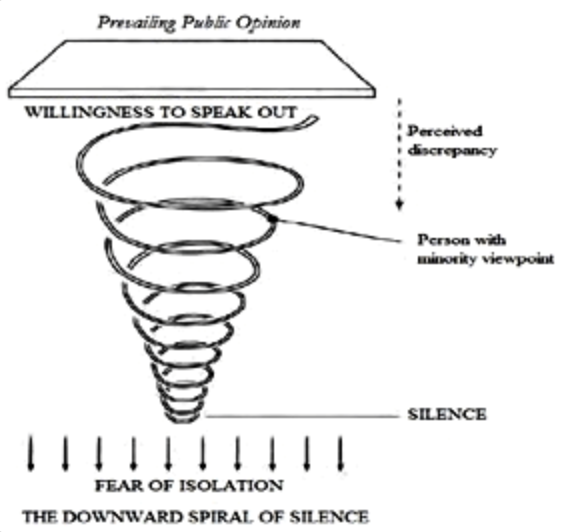Spiral of Silence Cap





Spiral of Silence Cap
Ribstop + Cotton
One Size Fits All | Expands after a few wears
Earth Brown
Embroidered front graphics in white and purple
Reflective print on back
Adjustable drawcord at back and sides
Reinforced black cotton side panels
Do not conform to the spiral of silence
Hand wash with like colors only | Hang dry, do not tumble dry
The Spiral of Silence
Spiral of Silence Model (Aryal, 2014; Noelle-Neumann, 1993)
The Spiral of Silence theory, proposed by German political scientist Elisabeth Noelle-Neumann, states that people are afraid of social isolation and therefore choose not to speak if they perceive that the majority opinion outweighs theirs. This suggests that people are inclined to remain silent or express their opinions less when they believe their viewpoints are in the minority, while those who perceive themselves to be in the majority are more likely to speak out.
How does it work
The theory states that individuals will constantly assess the prevailing public opinion on a particular issue through various channels such as media, social interactions, and observations. They try to gauge what the majority believes and whether their own opinions align with it.
When individuals perceive that their opinion differs from the majority or is unpopular, they experience a fear of isolation. This fear stems from the concern of potential social rejection, ostracism, or negative consequences for holding an unpopular opinion.
With the fear of isolation, individuals are more likely to remain silent about their divergent views. They may choose not to voice their opinions in public discussions, social settings, or even in surveys or polls. This silence reinforces the perception that their opinion is in the minority, further discouraging expression.
As the silent minority becomes less visible, the perception of the majority opinion grows stronger. People are more likely to assume that the prevailing opinion represents the true majority, as dissenting voices are suppressed. This amplification can further deter individuals from expressing their dissenting views.
The spiral effect occurs as more people conform to the perceived majority opinion, leading to an even greater silence among those who hold minority views. The spiral continues, reinforcing the dominance of the majority opinion and suppressing alternative perspectives.
Credits: NA
Musical Spiral
The theory holds outside the realm of verbal communication and can also be applied to other industries such as music. For instance, dominant trends and popular genres of music result in many artists conforming to the majority opinion of what is popular. They observe what is popular or trending, what gets airplay or what receives significant attention and recognition.
As such, many develop a fear of deviating from trends. And often at times, many of these musicians have unique or unconventional styles that may fear isolation or lack of acceptance and as a result, hesitate to express their artistic vision or experiment with different genres.
With more and more artists conforming to a specific trend, this results in these popular trends getting bigger and stronger. This creates a spiral where more and more unique and unconventional artists fall prey to the fear of rejection.
But with that being said, there are always artists who challenge conventions, embrace uniqueness and contribute to the diverse musical landscape. The theory simply explains potential pressures individuals may face in a social situation.


